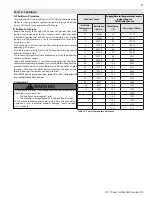
LP-719 Rev. 000 Rel. 000 Date 6.25.20
79
DANGER
!
Ensure power and gas to the appliance are shut off before
performing the following operations. Failure to do so will result in
substantial property damage, severe personal injury, or death.
C. Maintenance Only to be Performed by a Qualified
Service Technician
Removing the Cabinet Cover and Inspecting the Boiler
Before carrying out any work on the boiler, switch off the power
supply at the external power switch and circuit breaker. Close the
external gas shutoff.
See Figure 76 to access the interior of the boiler:
1. Release the four (4) latches from the front cover (two [2] each
side). Lift and remove the front cover from the cabinet (a).
2. Remove the screw securing the control panel to the cross-member
(b).
3. Push in the tabs and pull the control panel housing forward (c).
Figure 76 - Removing the Cover and Control Panel Housing
WARNING
!
Have leaks fixed at once by a qualified service technician. Failure
to comply could result in substantial property damage, severe
personal injury, or death.
Before Starting Maintenance:
1. Ensure the power and gas remain off.
2. Close the valves of heating and hot water circuit.
3. Remove the front panel as shown in Figure 76.
4. If necessary, empty the appliance on the water side.
Draining Procedure
To drain the heating system:
1. Ensure the boiler power and gas remain off.
2. Open the system drain valve and collect the escaping water in
a container.
3. Drain the water from the lowest points of the system (where
applicable).
If the system is to be inactive in areas where the room temperature
may fall below 0°C during winter, it is recommended that anti-freeze
liquid be added to the heating system in order to avoid the need for
repeated draining. Ensure the antifreeze used is compatible with the
stainless steel boiler heat exchanger.
WARNING
!
NEVER use any toxic chemical, including automotive, standard
glycol antifreeze, or ethylene glycol made for hydronic (non-
potable) systems. These chemicals can attack gaskets and seals in
water systems, are poisonous if consumed, and can cause personal
injury or death.
Check Water and Gas Piping
1. Remove the boiler cover and perform a gas leak inspection
following Operating Instructions on page 2 of this manual. If
gas odor or leak is detected, follow procedures on page 2. Call a
qualified service technician.
2. Visually inspect for leaks around the boiler water connections
and around the heat exchanger. Visually inspect the external
system piping, circulators, and system components and
fittings. Immediately call a qualified service technician to repair
any leaks.
It is recommended to use antifreeze which contains PROPYLENE
GLYCOLS as these inhibit corrosion. Use the quantities and
formulation suggested by the antifreeze manufacturer to protect
against freezing in your region and prevent scaling and corrosion.
Regularly check the pH level of the water/anti-freeze mix in the boiler
circuit and replace it when the value measured is lower than the limit
prescribed by the manufacturer.
DO NOT MIX DIFFERENT TYPES OF ANTI-FREEZE.
The manufacturer will not be held liable for any damage caused
by the appliance or the system due to the use of inappropriate
antifreeze substances or additives.
Draining the DHW System and Indirect Water Heater
Every time there is a danger of freezing, the domestic hot water
system must be drained as follows:
1. Shut off the main water inlet valve.
2. Open all the hot and cold water taps.
3. Drain the water from the lowest points of the system.
(b)
(a)
(c)











































